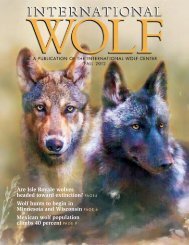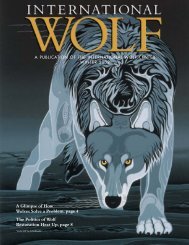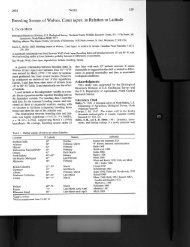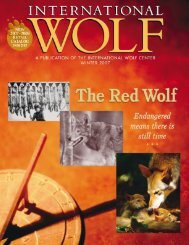a publication of the international wolf center spring 2007
a publication of the international wolf center spring 2007
a publication of the international wolf center spring 2007
Create successful ePaper yourself
Turn your PDF publications into a flip-book with our unique Google optimized e-Paper software.
Red <strong>wolf</strong> photo courtesy <strong>of</strong> Evelyn L. Mercer<br />
Interbreeding dilutes <strong>the</strong><br />
red <strong>wolf</strong> gene pool<br />
When a small red <strong>wolf</strong> population<br />
lives among an abundant coyote<br />
population, <strong>the</strong> two species will<br />
interbreed. This creates hybrids with<br />
part red <strong>wolf</strong> genes and part coyote<br />
genes. If unchecked, interbreeding<br />
could lead to an all-hybrid population,<br />
wiping out red wolves in just<br />
a few generations<br />
Back from <strong>the</strong> brink<br />
Once nearly extinct in <strong>the</strong> wild, red<br />
wolves were returned to a refuge in<br />
nor<strong>the</strong>astern North Carolina beginning<br />
in 1987. Red wolves thrive in <strong>the</strong><br />
recovery area today because <strong>the</strong> U.S.<br />
Fish and Wildlife Service prevents<br />
<strong>the</strong>m from interbreeding with coyotes.<br />
Coyote photo NPS by Judson<br />
Coyotes keep out!<br />
Biologists stopped <strong>wolf</strong>-coyote interbreeding<br />
in North Carolina by removing all coyotes<br />
and hybrids in Zones 1 and 2 <strong>of</strong> <strong>the</strong> red<br />
<strong>wolf</strong>- recovery area. To prevent coyotes from<br />
returning, <strong>the</strong>y sterilize coyotes and coyote-<strong>wolf</strong><br />
hybrids at <strong>the</strong> western edge <strong>of</strong> Zone 3. Ironically,<br />
<strong>the</strong> sterilized animals guard <strong>the</strong> territory, barring<br />
fertile coyotes from coming back and interbreeding<br />
with wolves.<br />
Red <strong>wolf</strong><br />
Canis rufus<br />
Looks: 42–84 pounds, with mostly brown,<br />
buff, or reddish-colored fur.<br />
Eats: Prey includes white-tailed deer, raccoons,<br />
and o<strong>the</strong>r small mammals, such as nutria (nonnative,<br />
beaverlike rodents), rabbits, and mice.<br />
Lives: Habitat in North Carolina includes<br />
agricultural lands, mixed forests, and wetlands.<br />
Population: 100 wolves<br />
Status: Endangered<br />
■ Historic range <strong>of</strong> <strong>the</strong> red <strong>wolf</strong><br />
■ Current range <strong>of</strong> <strong>the</strong> red <strong>wolf</strong><br />
■ Area related to this panel’s stories<br />
Note: The red <strong>wolf</strong> is a separate species from<br />
<strong>the</strong> gray <strong>wolf</strong>.<br />
Wanted: A home for wolves<br />
Today, wild red wolves thrive on an 875-squaremile<br />
peninsula in nor<strong>the</strong>astern North Carolina.<br />
To ensure <strong>the</strong> survival <strong>of</strong> <strong>the</strong> species, biologists<br />
must find at least two more places to establish<br />
separate populations <strong>of</strong> red wolves. Habitat<br />
shopping isn’t easy!<br />
Wanted: Two large tracts<br />
<strong>of</strong> undeveloped land in<br />
<strong>the</strong> sou<strong>the</strong>astern U.S.<br />
Low numbers <strong>of</strong> roads,<br />
coyotes, humans, and<br />
livestock a plus.<br />
Preferably near o<strong>the</strong>r<br />
areas <strong>of</strong> <strong>wolf</strong> habitat that<br />
can accommodate an<br />
expanding <strong>wolf</strong> population<br />
for years to come.<br />
Where else<br />
can wolves<br />
go? The dense<br />
populations <strong>of</strong><br />
humans and<br />
coyotes in <strong>the</strong><br />
Sou<strong>the</strong>ast and<br />
<strong>the</strong> absence <strong>of</strong><br />
large expanses<br />
<strong>of</strong> wild lands<br />
limit <strong>the</strong><br />
options.<br />
International Wolf Spring <strong>2007</strong> 15<br />
Fran Nolan







